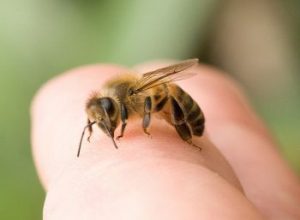- Home
- Editorial
- News
- Practice Guidelines
- Anesthesiology Guidelines
- Cancer Guidelines
- Cardiac Sciences Guidelines
- Critical Care Guidelines
- Dentistry Guidelines
- Dermatology Guidelines
- Diabetes and Endo Guidelines
- Diagnostics Guidelines
- ENT Guidelines
- Featured Practice Guidelines
- Gastroenterology Guidelines
- Geriatrics Guidelines
- Medicine Guidelines
- Nephrology Guidelines
- Neurosciences Guidelines
- Obs and Gynae Guidelines
- Ophthalmology Guidelines
- Orthopaedics Guidelines
- Paediatrics Guidelines
- Psychiatry Guidelines
- Pulmonology Guidelines
- Radiology Guidelines
- Surgery Guidelines
- Urology Guidelines
Wasp venom source of antibiotics to tackle resistant bacteria

The venom of insects is enriched with compounds which are bactericidal in nature and may act as antibiotic drugs.
A new study published in the journal Communications Biology has reported that the researchers at MIT have successfully created variants of the peptide that are effective against bacteria and safe to human cells.
The researchers conducted mice study in which they found that their strongest peptide could completely eliminate Pseudomonas aeruginosa, a strain of bacteria that causes respiratory and other infections and is resistant to most antibiotics.
"We've repurposed a toxic molecule into one that is a viable molecule to treat infections," says Cesar de la Fuente-Nunez, an MIT postdoc. "By systematically analyzing the structure and function of these peptides, we've been able to tune their properties and activity."
Read Also: Scorpion venom may lead to improved treatment option for rheumatoid arthritis
Antimicrobial peptides (AMPs) represent a promising alternative to conventional antibiotics because of their potency against difficult-to-treat infections4, such as the ESKAPE pathogens (Enterococcus faecium, Staphylococcus aureus, Klebsiella pneumoniae, Acinetobacter baumannii, Pseudomonas aeruginosa, and Enterobacter spp.). AMPs are produced as a mechanism of defense against infections.
Many organisms, including humans, produce peptides that can kill bacteria. To help fight the emergence of antibiotic-resistant bacteria, many scientists have been trying to adapt these peptides as potential new drugs.
The study was isolated from a wasp known as Polybia paulista. This peptide is small consisting 12 amino acids which made the researchers believe it would be feasible to create some variants of the peptide and tested them to see if they might become more potent against microbes and less harmful to humans.
"It's a small enough peptide that you can try to mutate as many amino acid residues as possible to try to figure out how each building block is contributing to antimicrobial activity and toxicity," said de la Fuente-Nunez, the lead author of the study.
Like many other antimicrobial peptides, this venom-derived peptide is believed to kill microbes by disrupting bacterial cell membranes. The peptide has an alpha-helical structure, which is known to interact strongly with cell membranes.
In the first phase of their study, the researchers created a few dozen variants of the original peptide and then measured how those changes affected the peptides' helical structure and their hydrophobicity, which also helps to determine how well the peptides interact with membranes. They then tested these peptides against seven strains of bacteria and two of fungus, making it possible to correlate their structure and physicochemical properties with their antimicrobial potency.
Based on the structure-function relationships they identified, the researchers then designed another few dozen peptides for further testing. They were able to identify optimal percentages of hydrophobic amino acids and positively charged amino acids, and they also identified a cluster of amino acids where any changes would impair the overall function of the molecule.
Read Also: Snake venom may replace aspirin for heart disease patients
To measure the peptides' toxicity, the researchers exposed them to human embryonic kidney cells grown in a lab dish. They selected the most promising compounds to test in mice infected with Pseudomonas aeruginosa, a common source of respiratory and urinary tract infections and found that several of the peptides could reduce the infection. One of them, given at a high dose, could eliminate it completely.
According to de la Fuente-Nunez, after four days, that compound can completely clear the infection, and that was quite surprising and exciting because we don't typically see that with other experimental antimicrobials or other antibiotics that we've tested in the past with this particular mouse model.
“Our study is an example of how to design small cationic amphipathic peptides to optimize biological activities and selectivity. We envision that the principles and approaches exploited here can be applied to other structure-activity studies in order to rationalize and better understand the role of physicochemical features and which approaches fit better to each family of peptides, ”write the authors.

Disclaimer: This site is primarily intended for healthcare professionals. Any content/information on this website does not replace the advice of medical and/or health professionals and should not be construed as medical/diagnostic advice/endorsement or prescription. Use of this site is subject to our terms of use, privacy policy, advertisement policy. © 2020 Minerva Medical Treatment Pvt Ltd